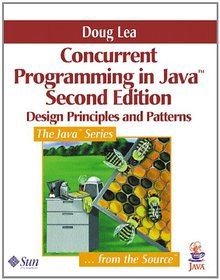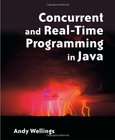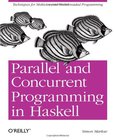Concurrent Programming in Java
Design Principles and Pattern
2nd Edition

Book Details:
| Publisher: | Addison-Wesley Professional |
| Series: | Addison Wesley , Principles |
| Author: | Doug Lea |
| Edition: | 2 |
| ISBN-10: | 0201310090 |
| ISBN-13: | 9780201310092 |
| Pages: | 432 |
| Published: | Nov 04 1999 |
| Posted: | Nov 19 2014 |
| Language: | English |
| Book format: | CHM |
| Book size: | 1.38 MB |
Book Description:
* One of Java's most powerful capabilities is its built-in support for concurrent programming, a design technique in which multiple concurrent activities-threads take place inside a single Java program. Thread programming enables developers to design applications that are more responsive to user demands, faster, and more easily controlled. * This book offers comprehensive coverage of this vital aspect of the Java language. The book is completely up-to-date with the new thread model that is now incorporated into the most recent version of the Java Virtual Machine. All Java programmers interested in doing concurrent programming must understand these new concepts. The book approaches the topic from a design pattern point of view. It introduces and summarizes Java's concurrency support, shows readers how to initiate, control, and coordinate concurrent activities, and offers numerous recipe-like techniques for designing and implementing Java structures that solve common concurrent programming challenges. Specifically, the book presents important strategies for avoiding the inconsistencies that can crop up in multi-threaded programs, addresses the concept of "liveness"-how to ensure that all threads in use are kept active simultaneously, examines state-dependent action, and demonstrates effective methods for handling user requests in a multi-threaded environment.
Download Link:
Related Books:
Concurrent and Real-Time Programming in Java
Real-time functionality is essential for developing many consumer, industrial, and systems devices. While the C/C++ programming language is most often used in the creation of real-time software, the Java language, with its simple and familiar object-oriented programming model, offers many advantages over current real-time practices. Concurrent and Real-Time Programming in Java covers the motivations for, and semantics of, the extensions and modifications to the Java programming environment that enable the Java platform (Virtual Machine) to meet the requirements and constraints of real-time development. Key aspects of concurrent and real-time programming and how they are implemented in Java are discussed, such as concurrency, memory management, real-t...
Parallel and Concurrent Programming in Haskell
Techniques for Multicore and Multithreaded Programming
If you have a working knowledge of Haskell, this hands-on book shows you how to use the language's many APIs and frameworks for writing both parallel and concurrent programs. You'll learn how parallelism exploits multicore processors to speed up computation-heavy programs, and how concurrency enables you to write programs with threads for multiple interactions. Author Simon Marlow walks you through the process with lots of code examples that you can run, experiment with, and extend. Divided into separate sections on Parallel and Concurrent Haskell, this book also includes exercises to help you become familiar with the concepts presented:Express parallelism in Haskell with the Eval monad and Evaluation Strategies Parallelize ordinary Haskell code with...
Concurrent Programming in Mac OS X and iOS
Unleash Multicore Performance with Grand Central Dispatch
Now that multicore processors are coming to mobile devices, wouldn't it be great to take advantage of all those cores without having to manage threads? This concise book shows you how to use Apple's Grand Central Dispatch (GCD) to simplify programming on multicore iOS devices and Mac OS X.Managing your application's resources on more than one core isn't easy, but it's vital. Apps that use only one core in a multicore environment will slow to a crawl. If you know how to program with Cocoa or Cocoa Touch, this guide will get you started with GCD right away, with many examples to help you write high-performing multithreaded apps.Package your code as block objects and invoke them with GCD Understand dispatch queuesthe pools of threads managed by GCD Use ...
2007 - 2021 © eBooks-IT.org



